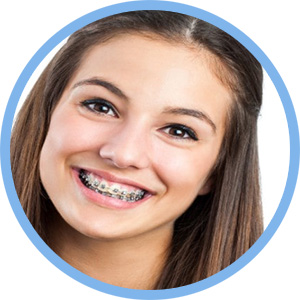When it comes to orthodontic treatment options, Waverly Dental offers a variety of braces for teens. The type of braces that are right for your teen depends on the issue being addressed as well as your teen’s goals and preferences. The first thing you need to know is the difference between the teeth-straightening options that are available.
 Traditional Metal Braces
Traditional Metal Braces
Traditional braces are tried and true, which is why they remain a popular teeth-straightening option. Today, brace wearers can have colorful bands of elastic placed around their brackets. The colors a teen chooses may represent an upcoming holiday, a sports team, or a favorite color.
Clear Bracket Braces
These braces are similar to traditional braces. The only difference is that these braces have clear brackets, which makes them less noticeable. Patients who are not considered good candidates for Invisalign frequently choose this teeth-straightening option. These braces are made from ceramic or porcelain as well as from plastic.
Metal Or Clear Damon Passive Self-Ligating Braces
Metal Damon passive self-ligating braces are much like the traditional metal braces, however, instead of using a metal ligature or tight elastic to hold the wire in place, self-ligating braces use a sliding door. This method is gentle, allowing the wire to slide back and forth within the metal bracket. Due to less friction, this teeth-straightening method provides patients with greater comfort than can be achieved with traditional metal braces. Furthermore, treatment with passive self-ligating braces is often shorter than the time required when traditional braces are used.
Clear Damon passive self-ligating braces offer patients a less-noticeable teeth-straightening option. These clear self-ligating braces consist of a high-quality ceramic that can blend with the patient’s natural tooth color. Although staining was a problem with the clear braces that were previously used, the Damon passive self-ligating braces will not stain.
Lingual Braces
These braces are made just like traditional metal braces; however, lingual braces are placed on the backside of the teeth. Although using this placement makes them completely invisible, it also makes cleaning them extremely difficult. In addition, lingual braces tend to require more adjustments than traditional metal braces that are placed on the front of the teeth.
Incognito Braces
This teeth-straightening system is also placed on the back of the teeth; however, these dental appliances consist of customized brackets and wires that are bent robotically. The brackets and wires are designed to work together, delivering targeted results. In addition, this teeth-straightening option offers patients more comfort than some of the other options. It is the low-profile, custom-designed brackets that improve comfort.
Another Teeth-Straightening Option Is Clear Aligners
There are numerous clear aligner teeth-straightening systems available, including Clear Correct and Invisalign. These systems consist of clear aligners that are worn from 20 to 22 hours a day. Two of the main benefits offered by these systems is the ability to discreetly straighten your teeth while continuing to eat whatever you want. With clear aligner systems, there are no food restrictions because the aligners are removed while eating and drinking. During treatment, the patient receives a series of custom-designed aligners. These aligner sets vary slightly and are switched out every week or two. These slight variances gradually move the teeth into their correct positions.
FAQ’s
How Long Will I Wear Braces?
This is probably one of the first questions patients ask. Understandably so. Since the orthodontists at Waverly Dental use their years of experience in conjunction with highly advanced teeth-straightening technologies, the length of time it takes to complete your treatment is faster now than ever before, with most patients completing treatment within 18 months to 24 months. However, since every patient is unique, the time it takes for you to complete your teeth-straightening treatment depends on your age, the orthodontic issue being addressed, and your dedication to following your treatment plan. An amazing result requires commitment.
What Foods Will I Have To Avoid When Getting Braces?
During treatment with braces, you will have limitations placed on the foods you can eat. Basically, anything that is chewy, hard, or sticky must be avoided. You will also need to cut up certain foods before you eat them (e.g., apples, etc.).
How Do I Care For My Teeth While Wearing Braces?
Properly caring for your braces during treatment is vital to the health of your teeth and your gums. You should brush thoroughly three times a day using a soft-bristled toothbrush and fluoride toothpaste approved by the American Dental Association. The toothbrush should place the tips of the bristles on the toothbrush against your teeth and brush using small circular motions. Since you have braces, you will need to brush a bit firmer than you did before having your braces placed. Each brushing session should last for two minutes.
As you brush, be sure to pay attention to the areas between your brackets and your gums as well as beneath the archwires. You can use Interdental brushes and floss threaders or dental flosses that have a built-in threader to clean in between your teeth and brackets. If you prefer, you can add oral irrigation to your dental hygiene routine.
How Do I Protect My Mouth When Playing Sports With Braces?
Protecting your mouth while playing sports and participating in activities where there is a risk of falling can be accomplished with a custom-designed mouthguard.
This mouthguard should be worn whenever you participate in physical activities and the following sports:
- Softball
- Baseball
- Basketball
- Football
- Soccer
- Rollerblading
- Gymnastics
- Karate
- Skateboarding
- Skiing
Athletes who have braces need to use a different type of mouthguard than athletes without braces. Since your teeth will be gradually moving, your Waverly Dental orthodontist can create you a custom-designed mouthguard to ensure your braces, gums, and teeth remain protected.
How Much Do Braces Cost?
The cost of braces usually depends on the type of braces being used (e.g., traditional metal, Damon passive self-ligating, etc.) and the issue being treated.
Benefits Of Braces For Teens
- Permanent teeth are gently guided into the proper position as soon as they begin to erupt.
- The braces guide the jaws when the teen has a growth spurt.
- There is a decrease in the risk of injuring the front teeth.
- The width of the dental arches is regulated.
- Abnormal speech or swallowing issues may be reduced or eliminated altogether.
- Harmful habits, such as finger or thumb sucking, may be corrected.
- An increase in self-esteem as the teen’s appearance improves.
- The likelihood of the teen experiencing impacted permanent teeth is reduced.
- Reduced disturbance of the airway, which decreases the incidence of sleep apnea as well as of snoring.
- An increase in the size of the spaces where the teen’s permanent teeth are to erupt. When these spaces are too small, the erupting tooth can damage the roots of the permanent teeth that are already in place.
If your teen has misaligned teeth that you would like to address, contact Waverly Dental to schedule a complimentary initial consultation with one of our experienced orthodontists.
At Waverly Dental, we are dedicated to providing each of our patients with the highest quality of care in a comfortable, state-of-the-art office with experienced and friendly orthodontists, oral surgeons, dental professionals, and staff.



